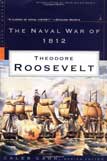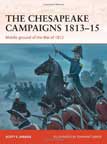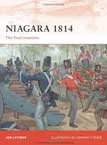

Published when Theodore Roosevelt was only twenty-three years old, The Naval War of 1812 was immediately hailed as a literary and scholarly triumph, and it is still considered the definitive book on the subject. It caused considerable controversy for its bold refutation of earlier accounts of the war, but its brilliant analysis and balanced tone left critics floundering, changed the course of U.S. military history by renewing interest in our obsolete forces, and set the young author and political hopeful on a path to greatness. Roosevelt's inimitable style and robust narrative make The Naval War of 1812 enthralling, illuminating, and utterly essential to every armchair historian.
Francis Scott Key's Star Spangled Banner, inspired by Fort McHenry's defense after the burning of Washington, DC, during the War of 1812, reminds Americans of a time when the United States faced a very real foreign invasion.
Arising out of a series of bitter commercial and naval disputes, and having as much to do with perceived slights to national pride as any pressing cause, the War of 1812 was never the most popular of conflicts on both sides of the Atlantic. Bogged down by their involvement in the Napoleonic conflict in Europe, the British largely relied on the power of the Royal Navy in the early years of the war.
Part of this naval strategy was to blockade the American coastline in order to strangle American commerce and bring the new nation to its knees. Nowhere was this blockade more important than in the Chesapeake Bay area, where a Royal Navy fleet under the command of Rear Admiral George Cockburn was on station. Partly in response to the sacking of York (modern Toronto), the British decided to strike at the nation's capitol, Washington, DC, and a force of Peninsular War veterans under General Robert Ross landed, defeated the Americans at the battle of Bladensburg and took Washington on August 24, 1814, burning the White House. Buoyed by this success, the British pressed on towards Baltimore. However, they were forced to withdraw at the battle of North Point, and a naval bombardment of Fort McHenry failed to reduce the fort and Baltimore was spared. With his intimate knowledge of the events in this theatre of war, Scott Sheads of Fort McHenry NPS brings these dramatic events of American history to life.
The War of 1812 (1812-1814) has the strange distinction of being a war largely forgotten by both of its main participants. Despite being overshadowed by the Napoleonic Wars raging in Europe, the War of 1812 saw Americans, British, Canadians, and Native Americans wage an increasing brutal conflict all along the border.
By 1814, with war coming to a close in Europe, the Americans decided to launch one last, major land offensive in an attempt to seize Canada. Although previous attempts had most often ended in disaster, the American army of 1814 contained several highly trained units under competent leadership including the legendary Winfield Scott. This final Niagara campaign saw a number of pitched battles including Chippawa, Lundy's Lane, and Cook's Mill, where the American Bluecoats matched the British shot for shot. However, due to poor planning at the highest levels of American office, the campaign was ultimately a failure and the result ensured the survival of Canada as an independent state.
A critically-acclaimed researcher on the War of 1812, author John Latimer presents a new look at an oft-forgotten yet crucially important campaign in the history of North America.
Roman Lower Rhine army proclaims its commander, Vitellius, Emperor
John II begins his reign as Catholic Pope
Emperor Joseph II orders Jews of Galicia Austria to adopt family names
Spain recaptures Granada from the Moors (Granada Day)
Tsar Ivan the Terrible march to Novgorod begins
Spain and Catholic France sign Saint League of Joinville
Battle at Kinsale, Ireland: English army beats Spanish
Spanish force in Ireland surrender to the English at Kinsdale
Staatsoper Hamburg opens with Theiles "Adam und Eva"
British troops occupy Calcutta India
1st revolutionary flag displayed
Austria ends interregation torture
Georgia is 4th state to ratify US constitution
Free black community of Philadelphia petitions Congress to abolish slave
US Sen Thomas Pickering is 1st senator censured (revealed confidential documents communicated by the President of the US)
Liberator, abolitionist newspaper, begins publishing in Boston
1st Curling club in US (Orchard Lake Curling Club) opens
1st photo of the Moon (French photographer Louis Daguerre)
1st US wire suspension bridge for general traffic opens in Penn
Colonel Charles Stone is put in charge of organizing DC militia
SC seizes inactive Ft Johnson in Charleston Harbor
Construction of Brooklyn Bridge begins
King Amadeus I of Spain inaugurated at 25
1st Test match hat-trick, Fred Spofforth at the MCG
British battleship Thunder explodes in Gulf of Ismid, 9 die
Dr Benjamin E Mays, named President of Atlanta Board of Education
Northwestern League (minor baseball league) organized, Rockford, Illinois
Because of anti-monopoly laws, Standard Oil is organized as a trust
Gen Wolseley receives last distress signal of General Gordon in Khartoum
Alice Sanger becomes 1st female White House staffer
1st US commemoratives and 1st US stamp to picture a woman issued
Battle at Doornkop, South Africa (Boers beat Dr Jamesons troops)
E Verlinger begins manufacturing 7" single-sided records (Montreal)
Gustave Charpentiers opera "Louise, " premieres in Paris
President Roosevelt shuts down post office in Indianola Miss, for refusing to accept its appointed postmistress because she was black
Elara, a satellite of Jupiter, discovered by Perrine
Japanese troops capture Port Arthur
Canadian branch of the Royal Mint opens in Ottawa
1st official Dutch 11 city skate (Minne Hoekstra in 13:50)
1st junior high schools in US opens (Berkeley, California)
Brooklyn Dodgers President Charles Ebbets announces purchase of grounds to build a new concrete-and-steel stadium to seat 30,000
Philips installs research department in Eindhoven
Dodgers trade Casey Stengel and Cutshaw to Pittsburgh for Grimes and Mamaux
NHL Montreal Wanderers disband after Westmount arena burns down
Anti-British uprising in Ireland
Lithuania gains independence
10,000 US union and socialist organizers arrested (Palmer Raids)
1st religious service radio broadcast in US, KDKA-Pittsburgh
DeYoung Museum in Golden Gate Park opens
Ku Klux Klan surprise attack on black residential area Rosewood Florida, 8 killed (compensation awarded in 1995)
Gorno-Badakhshan Autonomous Region established (now in Tadzhik SSR)
US and Canada agree to preserve Niagara Falls
Young gang shoot dead 6 police in Springfield, Missouri
Bruins beat Rangers in New York 13-3
Ijmuider fishing strike begins (till July 11th)
US troops leave Nicaragua
1st state liquor stores open, in Pennsylvania
Bradman scores 253 NSW vs. Queensland, 204 mins, 29 fours 4 sixes
Bruno R Hauptmann trial begins for kidnap-murder of Lindbergh baby
1st electron tube to enable night vision described, St. Louis, Missouri
Bradman scores 357 for South Africa vs. Victoria, 424 minutes, 40 fours
Book publisher Simon and Schuster founded
Bradman scores 107 South Africa vs. Victoria, his 4th consecutive century
28 nations, at war with Axis, pledge no separate peace
German troops in Bardia surrender
Japanese troops occupy Manila Philippines
1st use of helicopters during warfare (British Atlantic patrol)
Allied air raid on Neurenberg
Kentucky begins 130 home basketball game win streak, ends in 1955
Radio Orange ends cooperation at Liese-Aktion
Mahatma Gandhi begins march for peace in East-Bengali
WNDT (now WNET) TV channel 13 in New York-Newark, New York (PBS) begins
KDKA TV channel 2 in Pittsburgh, PA (CBS) begins broadcasting
"Pal Joey" opens at Broadhurst Theater NYC for 542 performances
NBA Baltimore Bullets begin a 32 game road losing streak
Herman Wouks "Caine Mutiny, " premieres in New York City
1st "Bob Cummings Show" premieres on NBC (later on CBS)
Poujadists / communists win French parliamentary elections
USSR launches Mechta (Luna 1) for 1st lunar fly-by, 1st solar orbit
Cuban Dictator Fulgencio Batista flees
1st redshank old world shore bird reported in North America (Halifax)
John F Kennedy announces run for US Presidency
John Reynolds sets age of solar system at 4,950,000,000 years
Senator John F Kennedy, announces his candidacy for President
1st AFL Championship Game, Houston Oilers beat LA Chargers 24-16
Nighttime version of "Password" with Allen Ludden premieres on CBS
Ayub Khan elected President of Pakistan
Failed assassination attempt on President Nkrumah of Ghana
Martin Luther King Jr begins a drive to register black voters
New York Jets sign quarterback Joe Namath
Obverse design of all Canadian coins is changed to depict present-day
1st Jewish child born in Spain since 1492 expulsion
Green Bay Packers beat Cleveland Browns 23-12 in NFL championship game
"Zizi" closes at Broadway Theater NYC after 49 performances
Christian Barnard performs 2nd heart transplant
KBHK TV channel 44 in San Francisco, CA (IND) begins broadcasting
"Fig Leaves Are Falling" opens at Broadhurst Theater NYC for 4 performances
"Soviet Sport" calls Emile Zatopek a public enemy
Dutch premiere of musical "Hair" in Amsterdam
US population is 293,200,000; Black population: 22,600,000 (11.1%)
A barrier collapses at Ibrox Park football ground at end of a soccer match in Glasgow Scotland, killing 66
"Rothschilds" closes at Lunt-Fontanne Theater NYC after 505 performances
Mariner 9 begins mapping Mars
Miami Dolphins beat Baltimore Colts 21-0 in AFC championship game
55 mph speed limit imposed by Richard Nixon
Worst fire in Argentine history destroys 1.2 million acres
US Department of Interior designates grizzly bear a threatened species
Bowie Kuhn suspends Braves owner Ted Turner for one year due to tampering charges in Gary Matthews free-agency signing
Rhino Records releases their 1st album "Wildmania"
30th Islander shut-out opponent-Glenn Resch 9-0 vs. Vancouver
Gavaskar gets twin tons for India for the third time (vs. West Indies)
68th Australian Men Tennis: Guillermo Vilas beat John Sadri (76 63 62)
Mary Terstegge Meagher swims female record 200 m butterfly (2:05.65)
Sylvester Clarke knocks out spectator with brick, WI vs. Pakistan
"Camelot" closes at Winter Garden Theater NYC after 48 performances
70th Australian Mens Tennis: Johan Kriek beats S Denton (62 76 67 64)
Islanders start 23 undefeated home streak (21-0-2) 14 straight wins
SD Chargers beat Miami Dolphins, 41-38 in 13:52 of OT
"Annie" closes at Alvin Theater NYC after 2,377 performances
"Sophisticated Ladies" closes at Lunt-Fontanne NYC after 767 performances
Don Muraco beats Pedro Morales to become WWF Intercontinental Champ
Gary Trudeau takes a 20-month break from writing "Doonesbury"
Ken Anderson of Cincinnati completes record 20 consecutive passes
Miami beats Nebraska in Orange Bowl for college football championship
Riot in Tunis kills over 100
90th hat trick in Islander history-Brent Sutter
Australia beat WI by innings at SCG, Bob Holland 10 match wkts
Egyptian President Mubarak reappoints Coptic Pope Shenuda III
Nevada-Las Vegas beats Utah 142-140, highest college basketball score
Undefeated BYU becomes college football champions
191.66 million shares traded in New York Stock Exchange
New York Islander, Mike Bossy, scores his 500th goal
Penn State upsets Miami in Fiesta Bowl for college football champ
Ashland Oil storage tank spills 3.8 million gallons, Penn
Mulroney and Reagan sign Canada-US free trade agreement
Notre Dame beats West Virginia for college football championship
UCLA wins a record 7th consecutive bowl game
Dow Jones hits record 2,800 (2,810.15)
Sting joins wrestlings 4 Horsemen (Flair, Arn Anderson, Ole Anderson)
Colorado wins its 1st AP national title poll
Test debut of Shane Warne, vs. India at Sydney
"Gypsy Passion" closes at Plymouth Theater NYC after 55 performances
"Abe Lincoln in Illinois" closes at Beaumont NYC after 40 performances
"Shakespeare after My Father" closes at Helen Hayes NYC after 266 performances
Battles between army and rebellious indians in South Mexico, kill 57
Bus crashes in Luzon Philippines, 29 killed
Carquest Bowl 5: South Carolina beats West Virginia, 24-21
Most distant galaxy yet discovered found by scientists using Keck telescope in Hawaii (est 15 billion light years away)
Howard Stern Radio Show premieres in Columbus OH on WBZX 99.7 FM
Autopsy of Chris Farley shows he overdosed of opiates and cocaine


